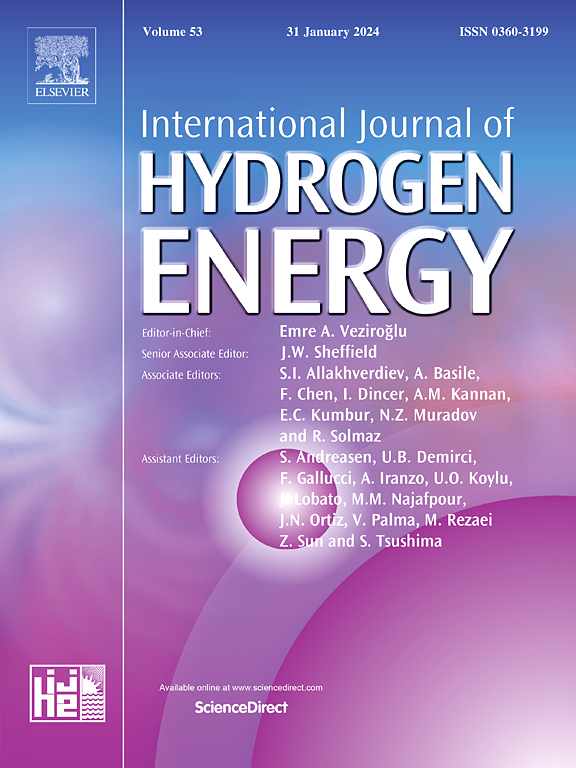Combined startup strategy of high temperature proton exchange membrane fuel cells
IF 8.1
2区 工程技术
Q1 CHEMISTRY, PHYSICAL
引用次数: 0
Abstract
High-temperature proton exchange membrane fuel cells (HT-PEMFCs) are one of the key focuses in hydrogen energy research. Achieving rapid operational temperature is a critical challenge. This study combines experimental and numerical methods to investigate combined start-up strategies for HT-PEMFCs. Initially, a single-cell HT-PEMFC was constructed to obtain polarization curves. Subsequently, a three-dimensional multi-physics numerical model was developed to determine start-up times and maximum temperature differences, proposing four start-up strategies: increasing inlet gas temperature, enhancing heating plate power, combined heating without and with incorporating heat recovery. Results indicate that increasing inlet gas temperature and using a heating plate each have limitations in start-up time and membrane temperature uniformity. The optimal strategy, combining 150 °C inlet gas and a 1200 W/m2 heating plate for startup, minimizes energy consumption. Additionally, incorporating heat recovery, both energy consumption and startup time can be reduced compared to scenarios without heat recovery, regardless of whether the priority is given to energy consumption or startup time.
高温质子交换膜燃料电池的联合启动策略
高温质子交换膜燃料电池(HT-PEMFC)是氢能研究的重点之一。实现快速的工作温度是一项关键挑战。本研究结合实验和数值方法,对高温质子交换膜燃料电池的联合启动策略进行了研究。首先,构建了单电池 HT-PEMFC 以获得极化曲线。随后,建立了一个三维多物理场数值模型,以确定启动时间和最大温差,并提出了四种启动策略:提高入口气体温度、提高加热板功率、无热回收和有热回收的联合加热。结果表明,提高进气温度和使用加热板在启动时间和膜温度均匀性方面各有限制。最佳策略是结合 150 °C 的入口气体和 1200 W/m2 的加热板进行启动,从而最大限度地降低能耗。此外,与不使用热回收的方案相比,无论优先考虑能耗还是启动时间,使用热回收都能减少能耗和启动时间。
本文章由计算机程序翻译,如有差异,请以英文原文为准。
求助全文
约1分钟内获得全文
求助全文
来源期刊

International Journal of Hydrogen Energy
工程技术-环境科学
CiteScore
13.50
自引率
25.00%
发文量
3502
审稿时长
60 days
期刊介绍:
The objective of the International Journal of Hydrogen Energy is to facilitate the exchange of new ideas, technological advancements, and research findings in the field of Hydrogen Energy among scientists and engineers worldwide. This journal showcases original research, both analytical and experimental, covering various aspects of Hydrogen Energy. These include production, storage, transmission, utilization, enabling technologies, environmental impact, economic considerations, and global perspectives on hydrogen and its carriers such as NH3, CH4, alcohols, etc.
The utilization aspect encompasses various methods such as thermochemical (combustion), photochemical, electrochemical (fuel cells), and nuclear conversion of hydrogen, hydrogen isotopes, and hydrogen carriers into thermal, mechanical, and electrical energies. The applications of these energies can be found in transportation (including aerospace), industrial, commercial, and residential sectors.
 求助内容:
求助内容: 应助结果提醒方式:
应助结果提醒方式:


